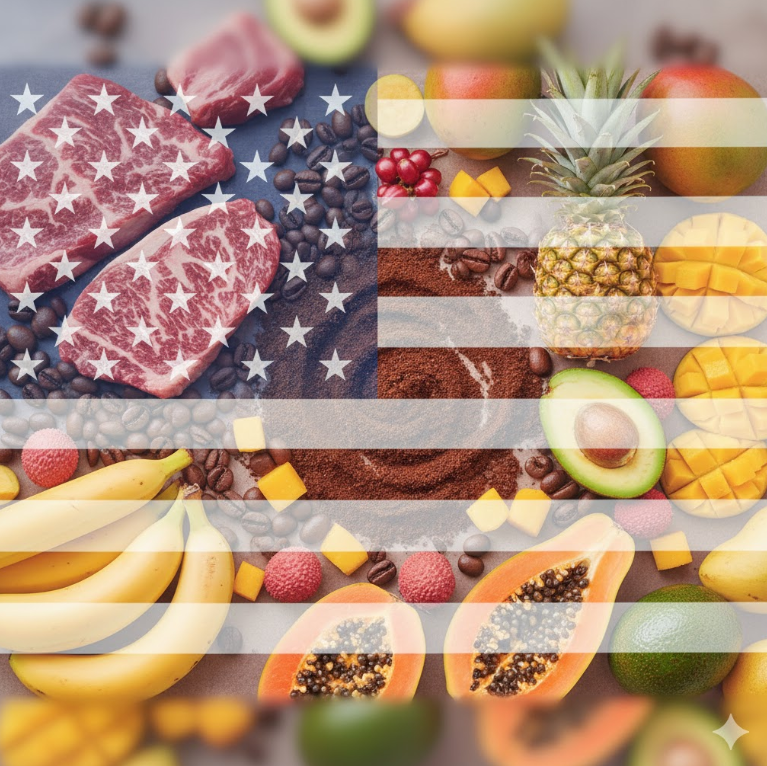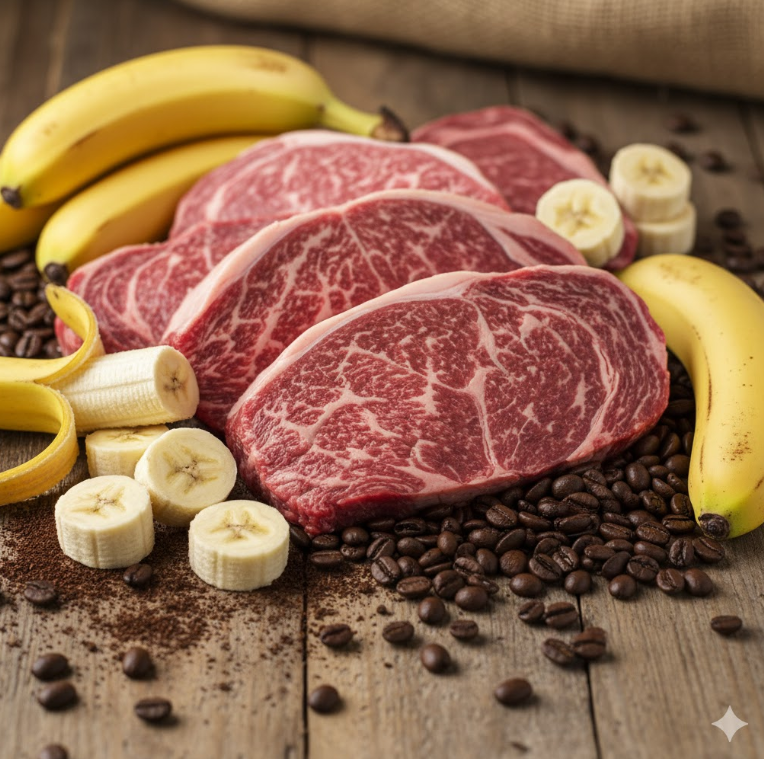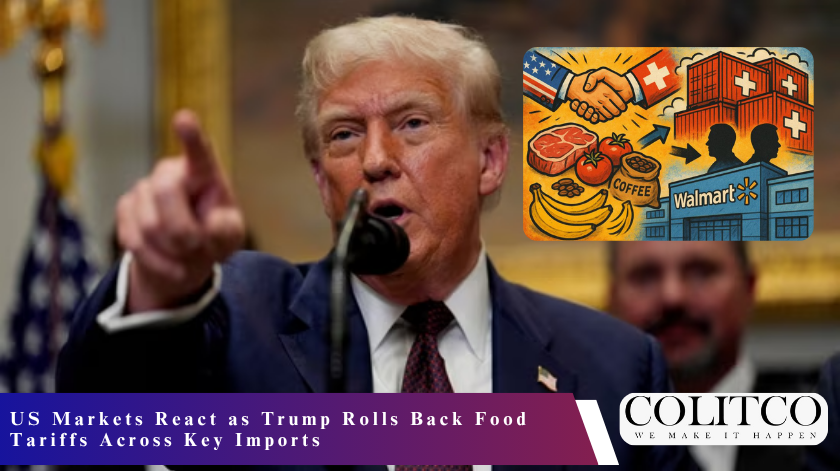The trump food tariff rollback marks a clear shift in the country’s approach to food imports, with the White House removing duties on a large group of agricultural and grocery items. The change comes at a time when Americans have been facing higher prices for everyday goods, placing pressure on households across many income levels.

The Trump food tariff rollback removes duties on beef, coffee, bananas and other key imports, easing food costs
The order affects more than 200 products, focusing on items the United States does not produce in large enough quantities to meet domestic demand. These include beef, coffee, bananas, tomatoes, orange juice, tropical fruit, and other goods that rely heavily on overseas supply.
Tariffs Removed on Beef, Coffee, Bananas, and Other Foods
Tariffs removed on beef, coffee bananas form one of the most notable parts of the policy. Beef from major exporting nations will now enter the United States without the previous duties. Coffee imports, which have been affected by rising global costs, are also included in the duty-free category.

Households faced rising prices for essentials such as coffee and bananas before the tariff rollback
Bananas join the list of products receiving tariff relief, alongside other fruit varieties sourced from Central and South America. The exemptions apply immediately, with the order taking effect from midnight before its announcement. The list also covers several processed goods, including juices and selected vegetable products that depend on international sources.
Rising Costs and Public Pressure Shape the Decision
The Trump Administration rolls back food tariffs action comes after a time during which the food prices in the country have increased. Coffee had increased by about 19% in the last year, and bananas increased by about 7%. These developments strained household incomes, particularly in states where wages have not increased in line with the cost of living.
In the recent state and local elections, voters expressed their worries regarding affordability and the increasing cost of basic food items. These interests became a key focus of the political discourse, making the administration review previous tariff policies. The transformation is a response to the problems brought out by consumers and community groups who have been demanding a way out of constant price pressures.
Trade Discussions Linked to the Rollback
The new tariff settings also reflect recent trade discussions between the United States and several partner countries. Framework talks involving Argentina, Ecuador, Guatemala, and El Salvador formed part of the lead-up to the decision. These countries export large volumes of products now covered under the updated tariff list.

While these agreements helped define some of the items eligible for relief, the rollback also extends to products from countries without current trade frameworks. This step suggests a broader move to support a consistent supply of essential goods, particularly where domestic production cannot meet national demand.
Industry Response as Retailers Await Price Movement
Food importers and distributors welcomed the trump food tariff rollback, noting that the earlier duties added pressure to supply-chain operations. Many businesses said the removal of tariffs may support better cost control in the months ahead. Retailers, meanwhile, have signalled that the easing of duties could help stabilise some prices once new shipments arrive.

Food distributors welcomed the removal of tariffs, which may ease supply-chain costs
However, some members of Congress raised concerns about the change, saying it represented a reversal from earlier policy positions. The administration had maintained for some time that tariffs were not contributing to higher food prices, and the decision has renewed debate among lawmakers about trade policy direction.
Current Price Trends and Possible Outcomes
Recent statistics have indicated general rises in the food categories, and coffee and bananas have been clear examples of household rising costs. The elimination of tariffs is among various measures that seek to alleviate pressure on families that have been experiencing gradual increases in their shopping bills weekly.
Although the tariff relief eliminates an extra cost to the importation process, the price adjustments will not be reflected on the shelves of the supermarket instantly. Shipping terms, supply options, and retailer pricing policies will contribute to the rate at which consumers are going to feel the change.
Also Read: “Very Standard?” Trump MRI Claim Sparks Surge of Questions
What the Trump Rolls Back Food Tariffs Move Means Going Forward
The Trump administration rolls back food tariffs measures, setting the stage for further discussion about future trade decisions. Some sectors have requested more extensive tariff adjustments, though the administration has not announced any additional changes. For now, attention will turn to how the retail market responds and whether the updated structure provides relief for families.
As the policy takes effect, consumers and producers will look for early signs of shifting price patterns. The trump food tariff rollback will remain a key part of the administration’s economic narrative as efforts continue to address the rising cost of living across the country.
FAQs
- What is the Trump food tariff rollback?
The Trump food tariff rollback refers to the removal of import duties placed on a range of food items. The change includes key products such as beef, coffee, and tropical fruit. The adjustment aims to ease pressure on household budgets and reduce costs for importers and retailers.
- Which food products had tariffs removed under the new policy?
Tariffs were removed on beef, coffee, and bananas, along with other tropical fruit. These items had carried higher costs under earlier trade settings. Their removal opens the door for lower wholesale prices and wider access to overseas suppliers.
- When were the food tariffs rolled back?
The rollback was announced as part of a broader trade shift outlined by the current US administration. It took effect immediately after the announcement, with industry groups notified of the new rules on the same day.
- Why did the government decide to remove these food tariffs?
The decision was taken to ease cost pressures and improve the supply of imported food. The move also aims to support the flow of goods that had been restricted under earlier tariff programs. Officials stated that households and retailers would benefit from the update.
- How will the rollback affect food prices in the United States?
Lower import costs may support price relief across affected food categories. Retailers may adjust pricing once new shipments arrive under the reduced-cost structure. The full change will depend on supply chains and existing stock under older tariffs.
- Does the rollback cover all food imports?
No. The rollback covers selected categories, including beef, coffee, and tropical fruit such as bananas. Other food products remain under existing tariff settings.
- How are farmers responding to the tariff removal?
Reactions vary across farming groups. Some domestic producers are reviewing the potential effect of cheaper imports entering the market. Others expect stable demand due to long-standing buyer relationships and local supply contracts.
- Will the tariff rollback affect trade relations with exporting countries?
Trading partners that supply beef, coffee, and tropical fruit are expected to welcome the adjustment. The rollback opens pathways for stronger export volumes into the US market.
- Are consumers expected to see immediate changes in stores?
Most changes will flow through gradually. Retailers need time to process new shipments, adjust supply agreements, and sell through existing inventory. Consumers may notice adjustments over the coming weeks.
- Could the tariff rollback be expanded in the future?
Officials have not confirmed additional changes. The trade team stated that the current update focuses on food items that carry high demand and steady import volume. Future changes would be assessed separately.












